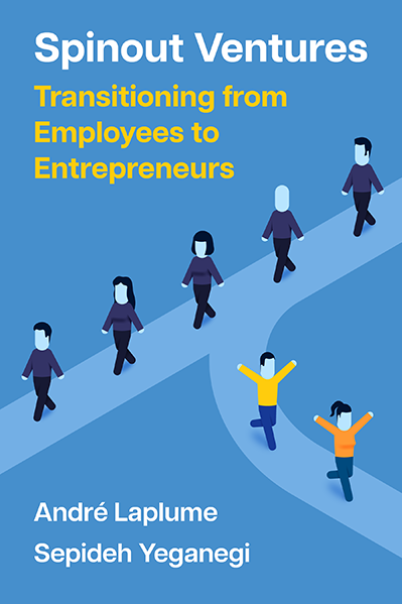Individual Ambidexterity and Entrepreneurship
Most new ventures are founded by former employees of organizations. Employees make discoveries while working for organizations and decide to exploit them on their own, especially when parent firms do not see the value in their discoveries, or choose not to exploit them due to a lack of fit with the firm’s strategy. When employees leave to start new ventures, we call their ventures employee spinouts.
Mom et al. (2015) propose that individuals working within organizations are ambidextrous if they are involved in both exploration and exploitation activities. Exploration and exploitation involve different types of learning and thus offer different preparatory experiences for individuals involved in them. According to March (1991), exploration involves activities such as search, play, experimentation, ideation, radical innovation, and formulation, whereas exploitation involves activities like refinement, execution, selection, implementation, and incremental improvement.
Yeganegi et al. (2019) propose that entrepreneurial preparation within their employing firms is important for employees turned entrepreneurs. Work experiences may be sources of entrepreneurial opportunities that employees can use to create new businesses and to potentially increase their economic and social mobility. The above argument suggests that when employees experience both exploration and exploitation (i.e., individual-level ambidexterity) in an organizational setting, they are mimicking the same stage-based processes that they will likely encounter in entrepreneurship.
Seeing the whole cycle of the business activity may enable employees to better recognize opportunities, reduce their uncertainty, increase the depth and breadth of their knowledge, and increase their perceptions of self-efficacy—all of which are expected to increase the likelihood of that they will become nascent entrepreneurs. The authors distinguish between exploration and exploitation experiences, thus draw on the individual ambidexterity literature for inspiration. Using data from the Global Entrepreneurship Monitor, their analyses suggest that employees who experience individual-level ambidexterity, that is exposure to both the exploration and exploitation phases in the corporate venturing process, are more likely to become nascent entrepreneurs.
The degree of ambidexterity that an individual may experience as a member of an organization is likely to differ according to the context internal to the organization. For example, organizations that break up exploration and exploitation tasks with structural separations may use differentiated incentive schemes (i.e., different rewards for those who are engaging in exploration than those for individuals specializing in exploitation). Alternatively, they may disallow overlapping cultures to form around exploration and exploitation activities and therefore be less likely to employ individuals who will experience ambidexterity at work. By contrast, organizations that practice contextual ambidexterity (Gibson and Birkinshaw, 2004), where both exploration and exploitation occur within the same organizational units are likely to accommodate ambidexterity experiences for more individuals.
Sources:
Kazanjian,R. K., and Drazin, R. (1990). A Stage-Contingent Model of Design and Growth for Technology Based New Ventures, Journal of Business Venturing, 5(3),137–150.
March, J.G. (1991). Exploration and Exploitation in Organizational Learning,Organization Science, 2(1), 71–87.
Mom, T. J., Fourné, S. P., and Jansen, J. J. (2015). ‘Managers’ work experience,ambidexterity, and performance: The contingency role of the work context,’Human Resource Management, 54(S1), 133-153.
Volery, T., Mueller, S., and von Siemens, B. (2015). Entrepreneur ambidexterity: A study of entrepreneur behaviours and competencies in growth-oriented small and medium-sized enterprises. International Small Business Journal, 33(2), 109-129.
Yeganegi, S., Laplume, A. O., Dass, P., and Greidanus, N. S. (2019) Individual‐Level Ambidexterity and Entrepreneurial Entry. Journal of Small Business Management. In press.
This video is about organizational ambidexterity:
